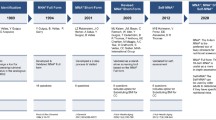Abstract
Objectives
Malnutrition is common in community-dwelling older adults and is associated with poor outcomes including hospitalization and mortality. Recently, a 6-question short form mini nutritional assessment (SF-MNA) was validated for rapid nutrition screening. Ideally, nutrition screening could be performed by individuals or their caregivers prior to or during an outpatient clinical visit, thus allowing for the ongoing monitoring of nutritional status among older adults.
Design
We compared the SF-MNA administered by a healthcare professional (HCP) to a 6-item self-administered screening tool (Self-MNA) in 463 community dwelling older adults who gave informed consent. The population was 60% women with a mean age of 76.8+6.8 years. The HCP was blinded to the results of the Self-MNA questionnaire.
Results
Using the SF-MNA, 27% of subjects were malnourished, 38% were at risk, and 35% had normal nutrition status. The agreement between the Self-MNA and the SF-MNA was 99% (Self-MNA sensitivity 99%, specificity 98%, false negative rate 1%, false positive rate 2%) for identifying Malnourished subjects and 83% (sensitivity 89%, specificity 77%, false negative rate 11%, false positive rate 23%) for identifying At Risk of Malnutrition compared to the MNA-SF administered by a HCP.
Conclusion
We found that the Self-MNA demonstrates sufficient inter-rater reliability for use in nutrition screening among community-dwelling older adults. Further validation studies and the possible impact of language translation should be pursued.
Similar content being viewed by others
References
National Center for Chronic Disease Prevention and Health Promotion CfDC. Chronic disease notes and reports: special focus. Healthy Aging 1999. Vol 12: Centers for Disease Control; 2000.
Kaiser MJ, Bauer JM, Ramsch C, et al. Frequency of malnutrition in older adults: a multinational perspective using the mini nutritional assessment. J Am Geriatr Soc. Sep 2010;58(9): 1734–1738.
Charlton K, Nichols C, Bowden S, et al. Poor nutritional status of older subacute patients predicts clinical outcomes and mortality at 18 months of follow-up. Eur J Clin Nutr. Sep 19 2012.
Mueller C, Compher C, Ellen DM. A.S.P.E.N. clinical guidelines: Nutrition screening, assessment, and intervention in adults. JPEN J Parenter Enteral Nutr. Jan 2011;35(1): 16–24.
Kondrup J, Allison SP, Elia M, Vellas B, Plauth M. ESPEN guidelines for nutrition screening 2002. Clin Nutr. Aug 2003;22(4):415–421.
Guigoz Y. The Mini Nutritional Assessment (MNA) review of the literature-What does it tell us? J Nutr Health Aging. Nov–Dec 2006;10(6):466–485; discussion 485–467.
Guigoz Y, Vellas B, Garry PI. Assessing the nutritional status of the elderly: The Mini Nutritional Assessment as part of the geriatric evaluation. Nutr Rev. Jan 1996;54(1 Pt 2):S59–65.
Rubenstein LZ, Hanker JO, Salva A, Guigoz Y, Vellas B. Screening for undernutrition in geriatric practice: developing the short-form mini-nutritional assessment (MNA-SF). J Gerontol A Biol Sci Med Sci. Jun 2001;56(6):M366–372.
Cronbach LJ. Coefficient alpha and the internal structure of tests.. Psychometrika. 1951;16:297–334.
Nunnaly J, ed Psychometric theory. New York: McGraw-Hill; 1978.
US Department of Health and Human Services Administration on Aging. Older Americans Act 2010; http://www.aoa.gov/AoARoot/AoA_Programs/OAA/index.aspx.
Centers for Chronic Disease Prevention and Health Promotion. Healthy Aging — Helping people to live long and productive lives and enjoy a good quality of life. Chronic Disease Prevention and Health Promotion. 2011. http://www.cdc.gov/chronicdisease/rsources/publications/aag/pdf/201l/Healthy_Aging_AAG_508.pdf. Accessed August 16,2011.
Bernstein M, Munoz N. Position of the Academy of Nutrition and Dietetics: food and nutrition for older adults: promoting health and wellness. J Acad Nutr Diet. Aug 2012;112(8): 1255–1277.
National Vital Statistics System, National Center for Health Statistics, Centers for Disease Control and Prevention. 10 leading causes of death by age group, United States—2009. 2011. http://www.edc.gov/Injury/wisqars/pdf/10LCD-Age-Grp-US-2009-a.pdf. Accessed June 28, 2012.
Kaiser MI, Bauer JM, Ramsch C, et al. Validation of the Mini Nutritional Assessment short-form (MNA-SF): a practical tool for identification of nutritional status. J Nutr Health Aging. Nov 2009;13(9):782–788.
Author information
Authors and Affiliations
Rights and permissions
About this article
Cite this article
Huhmann, M.B., Perez, V., Alexander, D.D. et al. A self-completed nutrition screening tool for community-dwelling older adults with high reliability: A comparison study. J Nutr Health Aging 17, 339–344 (2013). https://doi.org/10.1007/s12603-013-0015-x
Received:
Accepted:
Published:
Issue Date:
DOI: https://doi.org/10.1007/s12603-013-0015-x




